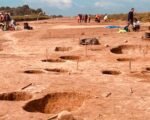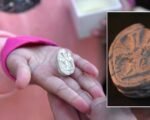A recent study has shed light on the enigmatic prehistoric stone balls found in various archaeological sites across the Northern Hemisphere. These stone artifacts, dating back to over 2 million years ago, have puzzled researchers for decades. The latest findings suggest that these stone balls were used by early humans to break open animal bones and extract nutritious marrow. This discovery provides a fascinating glimpse into the ingenuity and survival strategies of our ancient ancestors.
Discovery and Significance
The discovery of prehistoric stone balls in sites such as Qesem Cave in Israel has intrigued archaeologists for years. These spherical stones, often found alongside other ancient tools, were initially a mystery. Researchers have now determined that these stone balls were used as tools to access bone marrow, a vital source of nutrition for early humans.
The stone balls, made primarily of limestone and dolomite, were not perfectly round but had ridges and wear marks indicating their use. These features suggest that early humans used the stones to chip away at animal bones, effectively creating a “can opener” to access the marrow inside. This discovery highlights the resourcefulness of our ancestors in utilizing available materials to meet their dietary needs.

The significance of this finding extends beyond the practical use of the stone balls. It provides insight into the daily lives and survival strategies of early humans. Understanding how our ancestors used these tools helps us appreciate their ingenuity and adaptability in a challenging environment.
Research and Experiments
The research team, led by archaeologist Ella Assaf from Tel Aviv University, conducted extensive experiments to understand the function of the stone balls. They replicated the ancient tools and used them to break open animal bones, comparing the results with the wear marks found on the original artifacts. The experiments confirmed that the stone balls were highly effective in extracting bone marrow.
The team also used advanced microscopy techniques to analyze the wear patterns and organic residues on the stone balls. These analyses provided further evidence that the stones were used for marrow extraction. The findings were published in the journal PLOS One, adding a significant piece to the puzzle of early human tool use.
This research not only solves a long-standing mystery but also opens new avenues for studying prehistoric technology. By understanding the specific uses of these tools, researchers can gain a deeper understanding of the technological advancements and cultural practices of early human societies.
Implications for Archaeology
The discovery of the purpose behind the prehistoric stone balls has broader implications for the field of archaeology. It challenges previous assumptions about the complexity and sophistication of early human tools. The ability to create and use specialized tools for specific tasks indicates a higher level of cognitive and motor skills than previously thought.
This finding also underscores the importance of interdisciplinary research in archaeology. By combining experimental archaeology, microscopy, and residue analysis, the research team was able to uncover the true function of the stone balls. This approach can be applied to other enigmatic artifacts, potentially leading to new discoveries and insights into ancient human behavior.
Furthermore, the study highlights the value of revisiting and reanalyzing existing archaeological collections. Many artifacts that were previously dismissed as simple or unimportant may hold significant information about our ancestors’ lives and technologies. This discovery encourages archaeologists to look at old finds with fresh perspectives and innovative methods.













